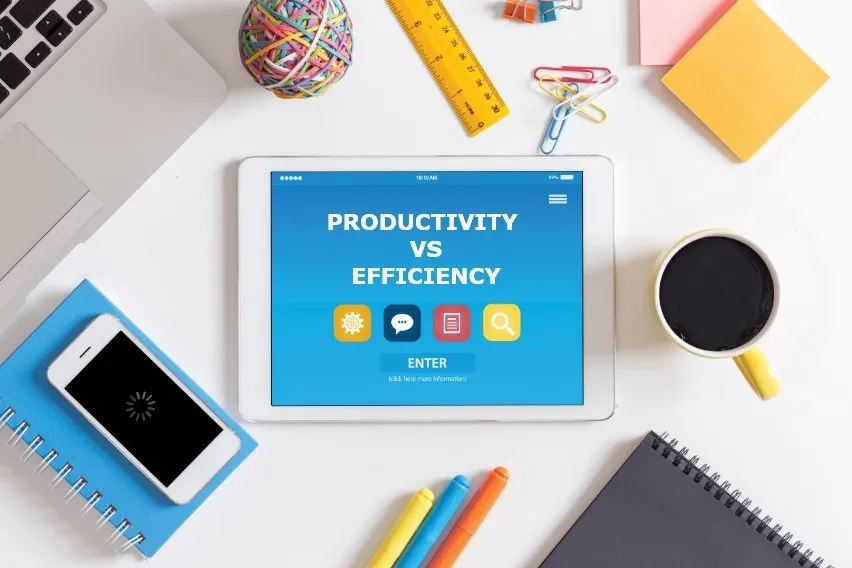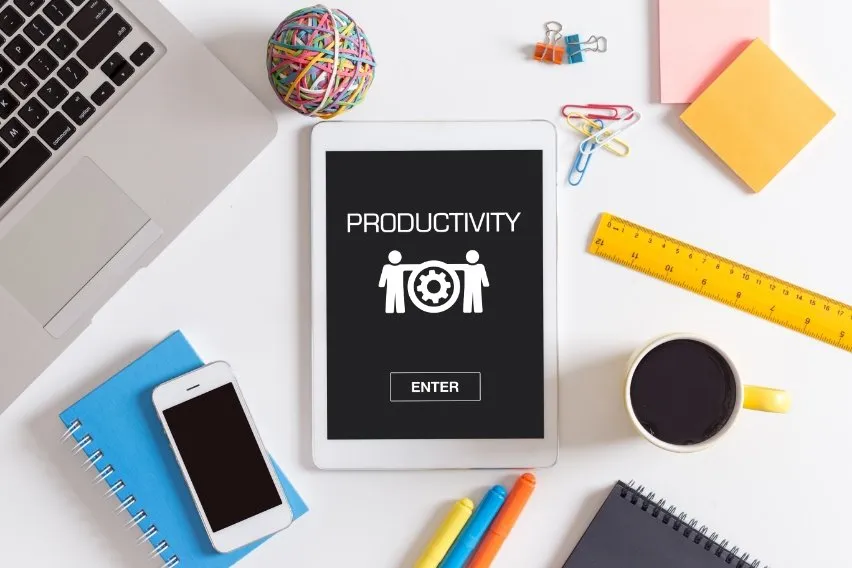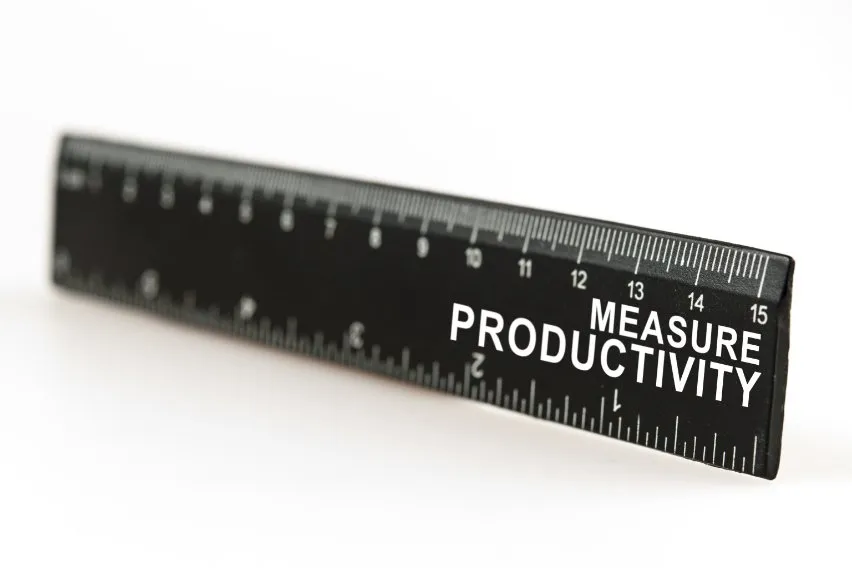Productivity vs Efficiency: What’s the Difference?

If you were to ask a business owner what they value most, they would likely say productivity. After all, the more you produce, the more success you can have.
But there’s another side to the coin when it comes to success. That being efficiency.
What is the difference between productivity and efficiency? And why are they both so important? Continue reading to learn about the definition of both, how they compare, and how to calculate them.
Table of Contents
How Do You Calculate Productivity and Efficiency?
The Importance of Productivity and Efficiency
Tips to Increase Productivity and Efficiency
What Is Productivity?
Productivity is a way to gauge how much work employees complete in a specific period of time. Output per hour is often used when measuring productivity. When employees can concentrate on their work and produce more in less time, productivity at companies often increases.
Productivity is also used to gauge how well a business runs its activities. Businesses can enhance productivity by spending less time on activities that don’t add much. This is to the organisation’s or the customer’s benefit.
Employees who are productive often have higher levels of motivation. They are also more fulfilled creatively and more inventive. And they deliver better results than those who are only marginally or barely productive.
Productivity evaluates both volume and output. It also considers the output, or how effective employees are at fulfilling their stated goals.
Productivity is crucial. It enables businesses to achieve their objectives while reducing labour and resource expenses. Numerous factors, including managerial techniques and technology, influence productivity.
What Is Efficiency?
Efficiency measures one’s capacity to complete a task with the lowest amount of energy and time possible. For example, if you are efficient, you might determine the optimal route to take to complete work or travel between two locations. So, while productivity may aid in completing activities fast, it does not ensure effectiveness.
Being efficient can help you save time and money, which is why it’s crucial in the office. Get your staff organised and aware of tasks so they can be effective.
Businesses that increase labour efficiency cut back on specific things. This includes total hours, staff, or budget to generate the same amount of work. These savings boost profitability.
Productivity vs Efficiency
When comparing both productivity and efficiency, it’s key to look at the same output. Efficiency refers to carrying out duties correctly, whereas productivity refers to completing tasks. If results are the main focus of productivity, then efficiency is all about the resources used to get those results.
Even if efficiency and productivity are two distinct things, it is important to remember that they relate to one another. Efficiency is the overall value and quality of that output if productivity were to relate to the quantity of output produced. So, in the event of resource scarcity, the procedure to accomplish the work becomes less efficient and affects the outcome.
Efficiency is quality, and productivity is quantity. The major distinction between the two is that neither is essential to the success of any firm. Efficiency quantifies the proportion of production that performs as intended. Productivity focuses on overall output.
So, most companies need both productivity and efficiency. They need both performance and the measurement of performance. Also, keep in mind that productivity does not account for underlying expenses, whereas efficiency does.
It is obvious that the two must interconnect for a business to experience great productivity. If they are separate, disastrous results might occur. Depending on the stage of the company’s life cycle, one may take priority over the other when it comes to production and efficiency.
For instance, when a business is first starting out, productivity takes priority. After all, a business must first build its foundation. They might then start concentrating more on efficiency as the business expands.
But having a productive workplace without efficiency is a surefire way to put an end to the company. This is especially true for many organisations in traditional manufacturing. You can only achieve true productivity and success when you have both.
The most effective method to do this is to combine productivity with efficiency. Don’t just presume that because you have one, you also have the other. In the end, true productivity depends on how well you use resources. And efficiency depends on what resources you use.
How Do You Calculate Productivity and Efficiency?
Calculating productivity enables your company to adapt and make adjustments for better outcomes. By doing this, you might highlight shortages or suggest steps to implement that can improve productivity. You’ll also clearly see any circumstances that would have hampered production.
When determining productivity, you have control over things like budgeting, target setting, and improvement. You also control estimates and allocation of raw materials. And by calculating your or your company’s efficiency, you may determine how resources are being used. In turn, you can prevent any unnecessary levels of waste.
Productivity Formula
We use this simple equation to measure productivity for each person, team, or department. The formula is as follows:

Productivity Calculation Example
Let’s say that Company X produces R1000,000 worth of goods in a single month. This is done through a total of 2,000 worked hours. With the above formula, we can use this information to track the productivity of Company X:
P = 1000,000 / 2,000
P = 500
This would mean that Company X generates R500 for each hour that they work. And that is how you measure productivity.
Efficiency Formula
You can better understand quantity by calculating productivity. Quality, on the other hand, is better assessed by calculating efficiency. Using the below formula is great for measuring efficiency within your company.
The formula for efficiency is as follows:
E = (EHW / AHW) x 100%
Where:
E = Efficiency
EHW = Expected number of labour hours worked
AHW = Actual number of labour hours worked
Efficiency Calculation Example
Let’s say that Freelancer X is working on a building site for a client. The expectation is that they work a standard work day of 8 hours. However, they actually finish all their agreed upon work in just 5.5 hours.
By using the above formula, we can use this information to figure out the efficiency of Freelancer X:
E = (8 / 5.5) x 100 = 145%
This shows that Freelancer X is working at 145% efficiency, which is a ratio that sits above the 100% threshold. That means that they are working 2.5 hours less than expected. Therefore, they are 45% more efficient.
The Importance of Productivity and Efficiency
Productivity
Productivity planning is a key metric in business. When a team is being productive, they are making the most of their time and the resources they have available to them. A productive team can bring huge benefits to a business and execute a large number of tasks in a short amount of time.
Efficiency
Efficiency is essential in any business environment. Workflows are often better when staff know exactly what it is that they are doing and how to execute it quickly. This frees up more time to concentrate on the work at hand rather than waste time attempting to determine what to complete next.
Tips to Increase Productivity and Efficiency
There are several advantages that come when you improve productivity and efficiency. This is true whether you’re a business looking to increase employee productivity or an employee trying to improve your individual performance. Increase efficiency and corporate productivity, and you will see economic expansion and better profits.
Many factors—such as a loss of desire, boredom, stress, or even health issues—can cause productivity to decline. But establishing a work environment that encourages focus and concentration will increase it. With all this in mind, let’s take a look at the following tips on how you can improve both facets.
Have a Clear Vision
Whether you’re a business owner or an employee, having a clear vision can help you produce consistent, long-lasting outcomes. Along with producing outcomes, it fosters teamwork and brings everyone together. Additionally, it raises the motivation and morale of workers. So, having a clear vision at work leads to improved productivity.
Keep Track of Time
Your or your team’s effectiveness may benefit from time tracking. This is one of the better ways to measure efficiency. You can have a clearer understanding of your daily tasks and enhance team job distribution. You may use your time more effectively and prevent inefficient resource use by keeping a close eye on how much time you spend doing each task.
Allocate Resources Properly
Allocating resources effectively is an enormous concern and obligation. You can avoid missed deadlines, excessive costs, and a dysfunctional workplace by effectively allocating time, money, people, and equipment. Keep in mind that productivity refers to the output that people produce when they use their resources efficiently.
Avoid Multitasking
The completion of jobs takes longer when several tasks are being handled at once. This act of multitasking and not wholly concentrating on one thing during a certain period hurts productivity. It also implies that you will become less productive as you take on more duties.
So, prioritise your workload and do vital jobs first rather than juggling multiple projects at once. You will effectively use your resources in this manner. And you can help to ensure that stalls in production won’t happen again.
Limit Distractions
Make sure that you are working in a space that is free from unnecessary distractions. What counts as a distraction may vary from person to person or from business to business. Common distractions include checking social media and emails. Other distractions are anything that might cause your mind to wander.
Key Takeaways
Efficiency and productivity are key terms in the workplace. Efficiency is the number of resources a corporation utilises to generate output. Whereas we define productivity as the amount of output a worker produces in relation to the input they put into their work.
Toeing the line between efficiency and productivity is not easy. But it is essential for producing consistent outcomes for your business. Your success depends on taking both variables into account and properly utilising them. This is true whether you are an individual or an institution.
If you’re struggling with either your productivity or your efficiency, take another look at our tips on improving them. Even making small changes in your day-to-day processes and routines can make a huge difference. And when you’re running a small business, even the finest of margins can make a big difference.
All in all, you want to make sure that you can work productivity and efficiency into your business in a way that benefits you and your employees.
FAQs on Efficiency vs Productivity
What Is an Example of Productive Efficiency?
So, when does a corporation reach production efficiency? When they can no longer create any more goods without influencing the production of other goods! An example of this is a company being unable to produce more glass vases without impacting the production of glass tables.
How Is Efficiency Measured?
We determine efficiency by dividing the expected number of labour hours worked by the actual number of labour hours worked. This number is then multiplied by 100.
What Is a Good Efficiency Ratio?
You should aim for 100% efficiency as a base standard. Anything below that means that you are working under optimal levels of efficiency. Anything above 100% is considered good. This is because you are working at a high level of efficiency.
RELATED ARTICLES


 Performance Plan – What Is It and How to Write the Plan
Performance Plan – What Is It and How to Write the Plan How to Increase Productivity in the Workplace (10 Easy Tips)
How to Increase Productivity in the Workplace (10 Easy Tips) Employee Development Plan: Benefits, Types & Steps
Employee Development Plan: Benefits, Types & Steps How to Measure Productivity: Best Methods & Tips
How to Measure Productivity: Best Methods & Tips Team Collaboration: Definition, Importance & Benefits
Team Collaboration: Definition, Importance & Benefits